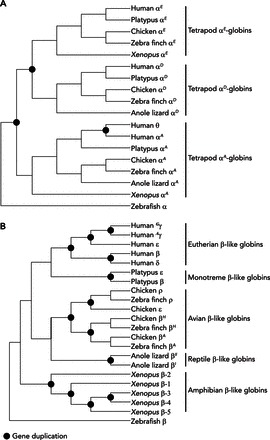FIGURE 3.

Diagrammatic phylogenies depicting the inferred relationships among members of the α- and β-globin gene subfamilies in tetrapods
In each tree, nodes depicted as filled symbols represent gene duplication events. The remaining nodes represent speciation events (phylogenetic splitting at the organismal level). A: phylogeny of α-type globin genes in representative tetrapod lineages. Note that the three paralogs (αE-, αD-, and αA-globin) are reciprocally monophyletic relative to one another. As discussed in the text, the αE- and αD-globin genes are products of a duplication event that occurred in the stem lineage of tetrapods. Orthologs of the embryonic αE-globin gene are known as αL-globin in amphibians, π-globin in birds, and ζ-globin in mammals. The human ortholog of the αD-globin gene is known as μ-globin. B: phylogeny of β-type globin genes in representative tetrapod lineages. Note that eutherian mammals, monotremes, birds, nonavian reptiles, and amphibians each inherited an ortholog of the same proto β-type gene, which then underwent one or more rounds of duplication and divergence to produce distinct repertoires of β-type globins in each descendent lineage. The depicted phylogenies are based on data reported in Refs. 43, 44, 59.
